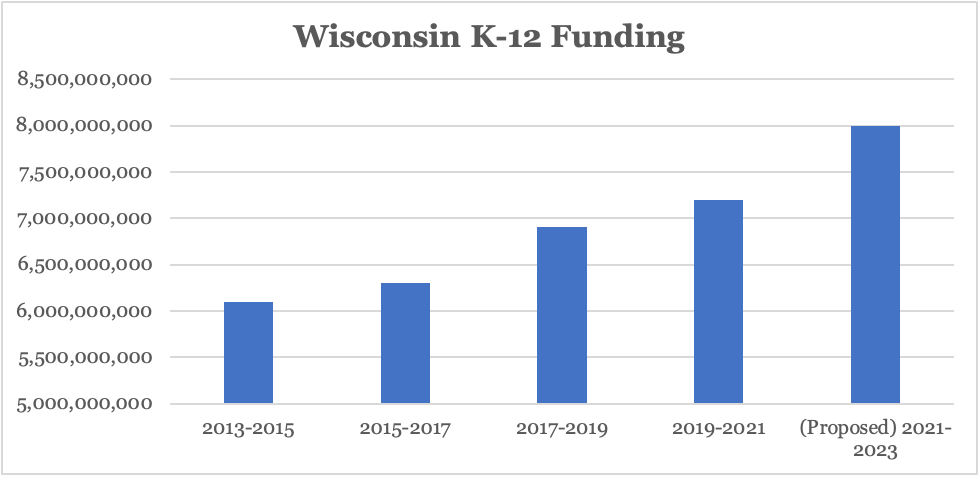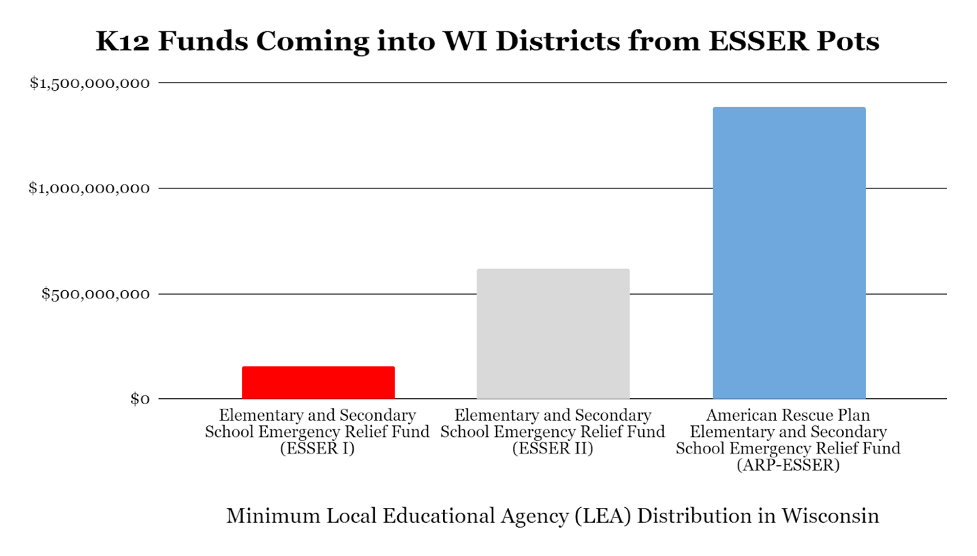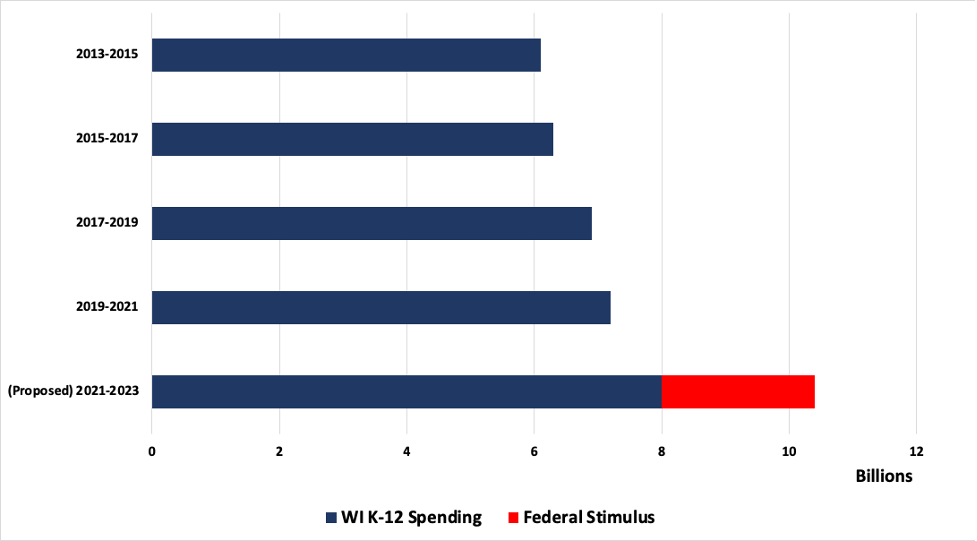By: Libby Sobic and Will Flanders, Ph.D.
Without fail, each state budget cycle always results in cries from the public school establishment that “we need more money in public schools!” Governor Evers continues this status quo assertion with his 2021-23 budget proposal for massive increases in spending for K12 education (about $1.7 billion). These declarations are often made without regard to the research showing that more money does not improve student proficiency. But as taxpayers in a state with low reading proficiency statewide, the largest racial achievement gap for minority students nationwide and immense learning disruption after the pandemic, Wisconsinites must expect local school districts to be smart about their investment of taxpayer dollars.
As the Joint Finance Committee debates Wisconsin’s education budget this week, the following will provide clarity around the state and local funds and federal stimulus funds flooding into the state.
K-12 Funding Pre-Pandemic
Wisconsin invests in our K-12 schools by creating options for families. On average, Wisconsin school districts average revenue (of local, state and federal funding) per student was $14,737 in 2019-2020.

Additionally, 21% of school districts went to local voters between 2019-2021 and raised more than $3.2 billion from property taxes via referendums.

The majority of K-12 education funding is directly distributed to school districts. Under current law, even the lowest funded school districts receive more funding per pupil than independent charter schools and private schools in the parental choice programs.
Today, the claims for more funding for districts are rendered almost comedic in light of all of the federal stimulus funds flooding into the state.
Federal Stimulus Funds: How Much Is “A Lot”?
The federal stimulus packages are sending billions of dollars into Wisconsin. School districts are a recipient of many of these funds. In addition to other sources, Congress also created three buckets of federal funding for districts—Coronavirus Aid Relief and Economic Security Act (CARES), Coronavirus Response and Relief Supplemental Appropriations Act (CRRSA), and American Rescue Plan Act (APRA). Each of these federal stimulus packages had dedicated funds for public elementary and secondary school districts (called ESSER funds).
So just how much money is there for Wisconsin school districts in these three stimulus packages alone? As shown in the figure below, school districts received a minimum of $157 million from CARES Act, a minimum of $617 million from CRRSA, and a minimum of $1.3 billion in APRA. This is described as the “minimum” amount because the Department of Public Instruction can use its ESSER funds to direct money to districts and Governor Evers has his own pots of federal funding to direct to districts.

The amount of money going to Wisconsin districts is staggering. The figure below shows the state’s investment into K-12 schools over the last five years as well as the federal stimulus funds specifically directed to public school districts starting in 2020.

On average, school districts throughout the state will see at least $2,267 per student in federal stimulus funds.
When school finance is focused on millions and billions, it can be difficult to understand what that means for the average person. So how much money is $2,267 per student? An average Wisconsin family will use this money for monthly expenses like healthcare, childcare, groceries and cell phone.

This federal funding is distributed based on a federal formula for low-income students. The table below lists 10 districts receiving the most and the least in dedicated federal stimulus education funding. This money is not distributed in anything close to an equal amount per student. The complete list of the estimated education federal stimulus funds can be found here. The following chart only incorporates funding from ESSER I, ESSER II, ESSER III and Governor Evers’s education funding under CARES Act (GEER I) allocations.
| School District (High) | Total Per Student | School District (Low) | Total Per Student |
| Granton Area | $14,576 | Kettle Moraine | $268 |
| Milwaukee | $11,242 | Cedarburg | $242 |
| Menominee Indian | $11,074 | Kimberly Area | $237 |
| Hillsboro | $10,351 | Hamilton | $232 |
| La Farge | $8,576 | Pewaukee | $229 |
| Lac du Flambeau | $8,323 | Slinger | $227 |
| Norwalk-Ontario-Wilton | $8,038 | Elmbrook | $202 |
| Greenwood | $7,273 | Waunakee | $202 |
| Washington | $5,975 | Arrowhead UHS | $183 |
| Royall | $5,956 | McFarland | $107 |
In some districts, the amount of federal funding nearly equals the total per pupil expenditure of state and local governments for the district. For example, in Milwaukee, per student spending before federal revenue was $13,166 for the 2019-20 school year. Federal stimulus dollars will equal about 83% of that.
It is critical to remember that these federal dollars are on top of existing state and local funding. As shown below, the districts receiving the most and the least amount in federal funding continue to receive full state funding for their students.

It is important to note that these numbers do not incorporate all of the federal funding available. Governor Evers will receive a total of $134 million in federal stimulus funds to use just for education. The Department of Public Instruction (DPI) also receives a 10% skim of each ESSER fund. DPI is asking the Joint Finance Committee to use ESSER III funds to give each school district at least $600,000 in federal funds and use another $77 million for formula grants to school districts. School districts may also receive additional stimulus funds through the Department of Health Services, local municipalities and other federal grants. So districts like Arrowhead UHS and McFarland will continue to get access to federal funding.
Of these districts, many, like Milwaukee and Arrowhead UHS, have even more funding due to referenda. Of the 100 districts receiving the greatest per pupil federal aid, 32 have passed referenda in the last year.
How Are These Federal Funds Being Spent?
The federal stimulus funds are flexible for school districts and, unfortunately, flowing into school systems with very little fiscal accountability and transparency.
Congress created specific categories for districts to allocate and use these federal stimulus funds. These categories include, any activities for coordination of preparedness and response to COVID-19, providing principals and school leaders with resources to address needs in individual school buildings, purchase of educational technology, activities for summer learning and afterschool programs, activities to help at-risk students, including children from low-income families, children with disabilities, English Language Learners, among others. The districts must also use a percentage of their federal funds to fund activities to address learning loss.
Despite this wide range of options, districts like Milwaukee Public Schools (MPS) are considering using the funds for pet programs like restorative practices for teachers. The MPS School Board is voting on a plan to spend over $3 million dollars of its ESSER II allocation on “restorative practices” for teachers and staff and $1.5 million for “bias and anti-racism trainings.” But this money should be going directly to families to address their educational needs. For example, if MPS just took the federal stimulus funds received under ESSER II, each MPS student could receive over $3,000 for their educational needs.
This is an unprecedented windfall of spending for local school districts across Wisconsin. With so much money flowing into schools, cries for more spending will ring more hollow than ever. Policymakers should take this opportunity to evaluate whether huge infusions of funding to local schools will actually improve performance in Wisconsin.